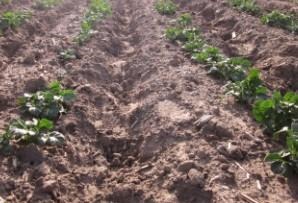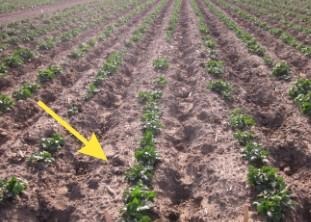Sarah Light, an agronomy farm advisor with the University of California Cooperative Extension, led a study on the timing of potassium chloride in potato fields. Her work was published in Agrosystems, Geosciences & Environment Journal, a publication of the American Society of Agronomy, and Crop Science Society of America.

Potatoes emerging in mounded rows at the study site in Hermiston, Oregon. The study focused on examining the timing of potassium chloride absorption in potato fields. After potatoes are harvested, the stems and leaves are usually left in the field. This can increase the risk of elevated chloride in the soil, but is avoided by applying potassium chloride in the fall. Credit: Sarah Light
In the study, the researchers applied three different potassium fertilizers at three different application times during the season. Potassium chloride is the most common and inexpensive potassium fertilizer. They also used sulfate of potash and sulfate of potash magnesia. They applied these fertilizers to different research plot 210 days before planting (fall), 14 days before planting (spring), and 35 days after planting.
They found that the fall application did not increase chloride in the plants. The researchers believe that this is because the chloride was leached below the root depth by the time the potatoes were planted 210 days later. However, the potassium was left in the soil to be taken up and used by the potatoes as they grew.
“Fertilizers are soluble salts and leaching is the process of draining salts from the soil,” Light explains. “Especially in low rainfall areas, high salt content in the crop rootzone, known as soil salinity, is a top reason that fields can become unfarmable.”
Although they did find higher chloride in some of the aboveground parts of the potato plant from spring and in-season applications, it did not greatly impact nitrogen levels. They also found no significant difference in yield or quality — such as specific gravity — between the three fertilizer timings in their specific study.
The study indicated that chloride accumulates more in the stems and leaves of the potato plant, and not in the potatoes themselves.

Rows of potato plants emerge from the soil and soak up the sun at the study site in Hermiston, Oregon. Layby fertilizer treatments were applied 35 days after planting. Potato plants had emerged but had not closed canopy at the time of the fertilizer application. Credit: Sarah Light
However, after potatoes are harvested, the stems and leaves are left in the field. The chloride isn't removed from the field and may increase the risk of elevated chloride in the soil for future seasons. In this study, chloride leached below the rootzone when applied in the fall.
“Potato plants will take up chloride when it is available and chloride will accumulate in plant tissue until potato harvest,” says Light. “Though specific gravity was not affected by treatment in this research, if elevated plant chloride is of concern, applying potassium chloride in the fall is a way to reduce chloride uptake. This is because it has time to travel, or leach, deeper into the soil.”
Light, who conducted this research while a graduate student at Oregon State University, says that she and her team were pleased to find that chloride can travel below the potato root zone, even in a low rainfall area. This provides a way for farmers to minimize risk of lower quality potatoes.
Click here to see more...